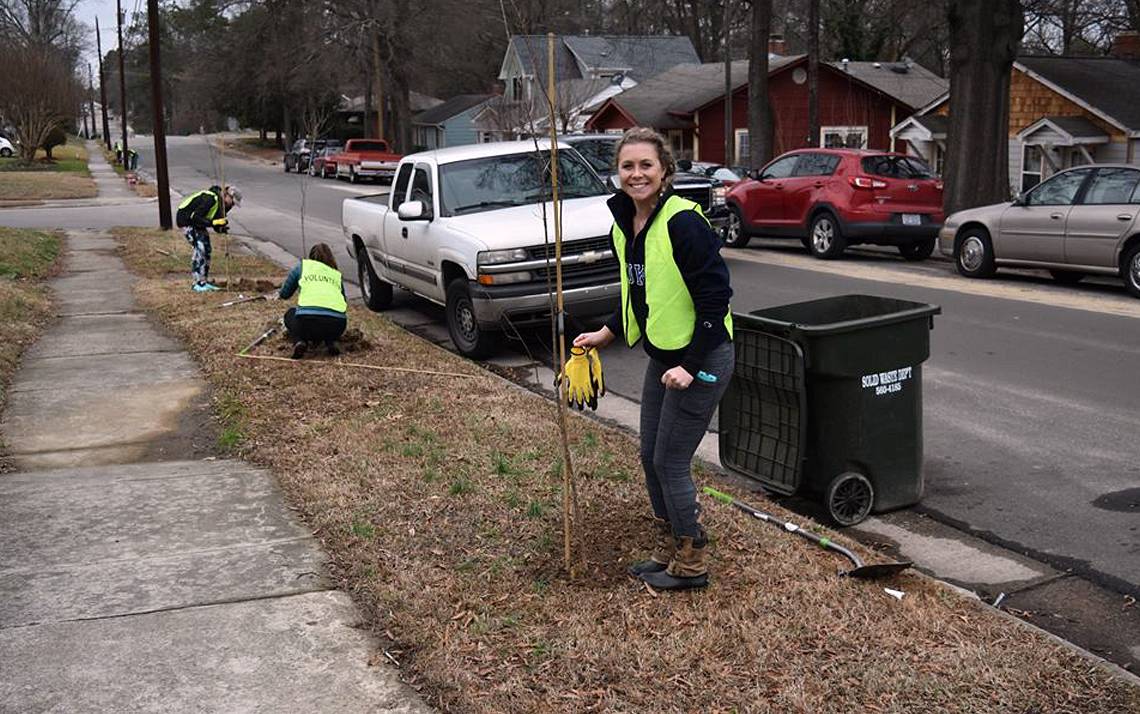The Hands-on Side of Offsets
Duke’s carbon offsets programs improve environment close to home

Ali Homan, a clinical nurse at Duke University Hospital, had just finished a night shift when she joined other volunteers on a Saturday morning to plant trees in Durham’s Walltown neighborhood.
A self-described “tree hugger,” Homan didn’t need convincing to go to the event, which was co-organized by local partners and the Duke Carbon Offsets Initiative (DCOI), a wing of Sustainable Duke.
“If I can do just a little bit to give back, then I feel like I’m maybe doing my part,” Homan said.
To her, planting young elms, oaks and maples earlier this year was simply a productive way to spend a morning. But for Duke, the planting is an example of a carbon offset program, one of the most important – and perhaps least understood – parts of Duke’s sustainability push.
Carbon offsets are activities that reduce or remove greenhouse gasses in the atmosphere in order to compensate for or counterbalance emissions elsewhere. Organizations hoping to lower environmental effects often pay for, or set up, offset programs.
Offsets loom large as Duke strives to achieve climate neutrality by 2024. As part of that goal, Duke is on track to reduce its emissions by 50 percent. But those efforts alone won’t be enough. In order to account for its remaining footprint and reach climate neutrality, Duke will have to offset an estimated 185,000 metric tons of carbon per year.
Combine big numbers and a somewhat abstract concept and it’s easy to see how people’s understanding of carbon offsets can be fuzzy.
“A lot of people I talk to don’t know what carbon offsets are at all,” said Tani Colbert-Sangree, DCOI program coordinator. “And then the rest of the people I talk to generally know the concept, but don’t fully understand what it means to ‘buy an offset.’”
Created in 2009, the DCOI was the first program of its kind at a college or university. It designs and develops projects that are less concerned with creating offsets now, but instead serve as prototypes for larger-scale solutions in the future.
For instance, at Loyd Ray Farms in Yadkin County, Duke oversees a project that captures methane from decomposing hog waste and burns it to create electricity for the farm. In addition to destroying the methane and creating renewable energy, the project has cut down on odor issues faced by nearby communities.
DCOI has also partnered with Greensboro-based company Urban Offsets to create an urban forestry program that supports tree plantings across the country – like the one Homan helped with. This year, the program will help plant and maintain more than 6,400 trees that will help sequester greenhouse gasses.
“Once they realize how we’re thinking about this holistically and they see how impactful these projects can be at a community level, then they really buy in,” Colbert-Sangree said. “People can see that, they understand that. They say ‘Oh, we’re helping the climate and we’re helping communities? That seems like a good project to support.’”